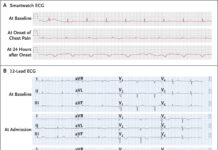Isolated Ulnar Shaft Fracture
A 60-year-old left-handed female patient reported to the emergency department with pain in her left forearm after being struck by her spouse with a baseball bat. The left forearm was enlarged and painful on physical examination, especially with passive pronation and supination. The overlaying skin was intact, and the neurovascular examination revealed no abnormalities. There were no other traumatic injuries. An isolated ulnar shaft fracture was seen on radiographs of the left forearm (upper picture, anteroposterior view; lower image, lateral view). Isolated ulnar shaft fractures, commonly known as “nightstick fractures,” are caused by forearm blunt force trauma.
The injury typically happens when the upper arm is raised in self-defense against a head or torso attack, such as in intimate-partner violence, as in this example. Comprehensive examinations of the patient’s safety and mental health were undertaken, and social assistance were provided. Although this sort of injury may be managed nonoperatively in some situations, the patient had open reduction and internal fixation of the fracture, followed by splinting. At the 10-week follow-up, the patient had restored full arm function, received a restraining order for protection, and was receiving aid from a social worker.
Distal ulna fractures usually occur with distal radius fracture
Distal ulna fractures are uncommon and usually occur in conjunction with a distal radius fracture. Adults with combined distal radius and distal ulna fractures are more likely to be over 65 years old and are related with osteoporosis. Ulnar styloid tip fractures are quite prevalent, accounting for 55% of distal radius fractures. The vast majority of these are stable and are handled cautiously. Ulnar metaphyseal fractures are uncommon, accounting for just 5-6% of distal radius fractures. The ulnocarpal joint bears about 20% of the strain across the wrist when the wrist is in neutral rotation. When the forearm rotates into pronation or grips, there is a relative increase in ulnar length, which increases the fraction of load transmission through the ulnocarpal joint.
The distal ulna has three subregions. The distal ulnar metaphysis, the ulnar styloid base, and the ulnar styloid tip. The Triangular FibroCartilage Complex (TFCC) and the ulnocarpal ligaments are held together by the ulnar styloid. The TFCC maintains the congruence of the distal radius and ulnar head, as well as the proximal carpal row. The TFCC is made up of both superficial and deep components. The superficial ligaments are attached to the ulnar styloid tip, and the deep fibres are attached to the fovea of the ulnar head at the base of the ulnar styloid.
The distal ulna is divided into three segments
The ulnar styloid base, the ulnar styloid tip, and the distal ulnar metaphysis. The ulnar styloid connects the Triangular FibroCartilage Complex (TFCC) to the ulnocarpal ligaments. The TFCC keeps the distal radius and ulnar head, as well as the proximal carpal row, congruent. The TFCC is composed of both surface and deep components. The superficial ligaments are linked to the ulnar styloid tip, whereas the deep fibres are attached to the ulnar head fovea at the base of the ulnar styloid.
A distal ulnar metaphysis fracture is one that occurs within 5cm of the ulnar head’s distal ulnar dome
The bony structure (including the shape of the sigmoid notch of the distal radius) as well as the surrounding ligaments and muscles dictate the stability of the DRUJ. The stabilising structures are as follows:
- TFCC stands for Triangular FibroCartilage Complex.
- Complex of the ulnocarpal ligaments.
- Pronator Quadratus (PQ) muscle Extensor Carpi Ulnaris (ECU) tendon and tendon sheath.
- Joint capsule interosseous membrane (IOM) and interosseous ligament (IOL).
Treatment for isolated ulnar shaft fractures
For ulnar styloid and ulnar head / neck fractures, the Synthes 2.0mm Locking Compression Plate for Distal Ulna fractures is advised. The plate is anatomically shaped and has a low profile, reducing the need for significant soft tissue dissection and the likelihood of implant removal due to soft tissue irritation. Through Combi holes in the plate shaft portion, the plate accepts both non-locking and fixed angle locking screws. The use of non-locking screws in the shaft portion enables length modification as well as dynamic fracture compression. There is a cut on the plate on the underside of the implant that enables for contouring if necessary.
The distal section only accepts locking screws, which give angular stability and, when combined with the hook section, provide adequate fixation to a fracture fragment that is frequently quite small. The hook part also allows the plate to be fitted correctly and provides an excellent indication of reference height and plate location. A 1.1mm K-wire can be placed between the hook’s prongs to temporarily retain the reduction or a 1.5mm non-locking screw can be used to stabilise a styloid tip fracture.
Source: NEJM




